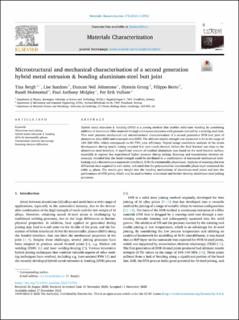| dc.contributor.author | Bergh, Tina | |
| dc.contributor.author | Sandnes, Lise | |
| dc.contributor.author | Johnstone, Duncan Neil | |
| dc.contributor.author | Grong, Øystein | |
| dc.contributor.author | Berto, Filippo | |
| dc.contributor.author | Holmestad, Randi | |
| dc.contributor.author | Midgley, Paul Anthony | |
| dc.contributor.author | Vullum, Per Erik | |
| dc.date.accessioned | 2022-02-14T10:18:39Z | |
| dc.date.available | 2022-02-14T10:18:39Z | |
| dc.date.created | 2020-12-04T12:30:36Z | |
| dc.date.issued | 2020 | |
| dc.identifier.citation | Materials Characterization. 2020, . | en_US |
| dc.identifier.issn | 1044-5803 | |
| dc.identifier.uri | https://hdl.handle.net/11250/2978706 | |
| dc.description.abstract | Hybrid metal extrusion & bonding (HYB) is a joining method that enables solid-state bonding by combining addition of aluminium filler material through continuous extrusion with pressure exerted by a rotating steel tool. This work presents mechanical and microstructural characterisation of a second generation HYB butt joint of aluminium alloy 6082 and structural steel S355. The ultimate tensile strength was measured to be in the range of 184–220 MPa, which corresponds to 60–72% joint efficiency. Digital image correlation analysis of the strain development during tensile testing revealed that root cracks formed, before the final fracture ran close to the aluminium-steel interface. A significant amount of residual aluminium was found on the steel fracture surface, especially in regions that experienced higher pressure during joining. Scanning and transmission electron microscopy revealed that the bond strength could be attributed to a combination of microscale mechanical interlocking and a discontinuous nanoscale interfacial Al-Fe-Si intermetallic phase layer. Analysis of scanning electron diffraction data acquired in a tilt series, indicated that the polycrystalline intermetallic phase layer contained the cubic αc phase. The results give insight into the bonding mechanisms of aluminium-steel joints and into the performance of HYB joints, which may be used to better understand and further develop aluminium-steel joining processes. | en_US |
| dc.language.iso | eng | en_US |
| dc.publisher | Elsevier | en_US |
| dc.rights | Navngivelse 4.0 Internasjonal | * |
| dc.rights.uri | http://creativecommons.org/licenses/by/4.0/deed.no | * |
| dc.title | Microstructural and mechanical characterisation of a second generation hybrid metal extrusion & bonding aluminium-steel butt joint | en_US |
| dc.type | Peer reviewed | en_US |
| dc.type | Journal article | en_US |
| dc.description.version | publishedVersion | en_US |
| dc.source.pagenumber | 13 | en_US |
| dc.source.journal | Materials Characterization | en_US |
| dc.identifier.doi | 10.1016/j.matchar.2020.110761 | |
| dc.identifier.cristin | 1856232 | |
| dc.relation.project | Norges forskningsråd: 245963 | en_US |
| dc.relation.project | Norges forskningsråd: 237900 | en_US |
| dc.relation.project | Norges forskningsråd: 197405 | en_US |
| cristin.ispublished | true | |
| cristin.fulltext | postprint | |
| cristin.qualitycode | 1 | |

